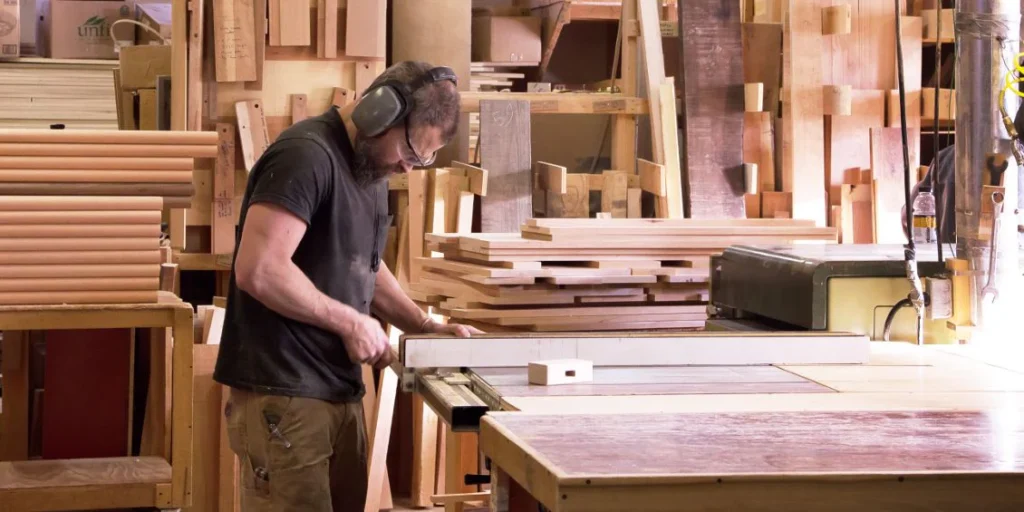Furniture craftsmanship combines traditional skills with modern aesthetics to produce items that are not just functional but also artistically significant. This art form emphasizes quality and durability, distinguishing handcrafted pieces from those that are mass-produced, thereby offering unique and enduring furniture options.
In an era where cheap, disposable furniture is common, craftsmanship brings a crucial counterpoint. It emphasizes durable materials and designs that stand the test of time, offering a sustainable alternative that respects both craftsmanship traditions and the environment.
This comprehensive guide will delve into the nuances of furniture craftsmanship, exploring its historical roots, current trends, and future direction. Whether you are a maker, a buyer, or an enthusiast, you’ll find in-depth information to deepen your appreciation and understanding of crafted furniture.
History of Furniture Craftsmanship
Early Practices and Techniques
From ancient Egyptian wooden constructions to the intricately joined Asian furniture, the early techniques of furniture craftsmanship laid a foundation that has stood the test of time, influencing countless generations of furniture makers.
Evolution Through the Centuries
As societies evolved, so did the techniques and styles of furniture craftsmanship. Each era brought its own influences, with European craftsmen developing detailed marquetry and veneering techniques during the Renaissance, which were later perfected in the Baroque and Rococo periods.
Influential Furniture Makers in History
Historical figures such as Thomas Chippendale, the Shakers, and Gustav Stickley have left indelible marks on furniture craftsmanship. Their innovative designs and philosophical approaches to workmanship have shaped modern furniture making practices.
Fundamental Materials in Furniture Making
Types of Wood Used in Furniture
Woods like oak, mahogany, and walnut have been staples in the craftsman’s palette for centuries due to their beauty and resilience. Each type of wood offers different textures, colors, and grain patterns, providing a rich selection for bespoke pieces.
Metal and Glass in Contemporary Designs
Modern craftsmen often incorporate materials like metal and glass into their designs, pushing the boundaries of traditional woodworking. These materials bring contemporary elegance and structural innovation to classic craftsmanship.
Emerging Sustainable Materials
Today, sustainability is as important as aesthetics and functionality. Materials like reclaimed wood, bamboo, and recycled metals are gaining popularity among craftsmen who are committed to reducing environmental impact while maintaining high-quality outputs.
Tools of the Trade
Basic Tools for Beginners
For those new to furniture craftsmanship, starting with essential tools like saws, planes, and chisels is crucial. These tools enable beginners to learn the fundamental techniques of cutting, shaping, and assembling wood.
Advanced Machinery for Professional Craftsmen
Professional craftsmen utilize advanced tools such as CNC machines and laser cutters to enhance precision in complex projects. These technologies allow for intricate designs and efficient production processes.
Maintaining Tools for Longevity
The longevity of tools is critical for maintaining consistent quality in craftsmanship. Regular maintenance, including cleaning, sharpening, and proper storage, ensures that each tool performs at its best for every project.
Design Principles in Furniture Craftsmanship
Balancing Form and Function
Effective furniture craftsmanship seamlessly integrates form with function. Each piece must not only be visually appealing but also serve its intended practical purpose, reflecting the skill of the craftsman.
Influence of Style and Era on Design
Understanding historical and cultural influences on furniture design is essential for craftsmen. This knowledge allows them to create pieces that resonate with specific eras or contemporary trends, catering to diverse tastes.
Innovative Design Trends
In the realm of furniture craftsmanship, innovation is key. Today’s craftsmen are exploring minimalist designs, modular functionalities, and eco-friendly materials, all while adhering to the timeless principles of skilled woodworking.
Techniques in Woodworking
Carving: Techniques and Tips
Carving is a form of expression in furniture craftsmanship that allows for intricate designs and personalization of pieces. Skilled artisans use various tools to sculpt and detail wood, creating patterns and motifs that enhance the visual appeal of their work.
Joinery: Ensuring Durable Connections
Effective joinery is fundamental to the durability and quality of furniture. Techniques like dovetails, mortise-and-tenon, and box joints not only ensure strong bonds but also exhibit the craftsman’s attention to detail and dedication to longevity.
Finishing: Achieving a Professional Look
The final finish on a piece of furniture not only protects the material but also brings out the natural beauty of the wood. Techniques such as staining, sealing, and lacquering can dramatically affect the appearance and durability of the finished product.
Upholstery and Soft Furnishings
Choosing Fabrics and Materials
The choice of fabric and materials in upholstery significantly impacts both comfort and style. Craftsmen must select high-quality textiles that complement the design and functionality of the furniture, ensuring that it meets the aesthetic and practical needs of the user.
Tools for Upholstery
Upholstery requires a unique set of tools, from staple guns to sewing machines. These tools help craftsmen apply fabric tightly and evenly, achieving a professional and durable finish that enhances the comfort and appearance of the furniture.
Techniques for Long-Lasting Upholstery
Mastering upholstery techniques such as button tufting, cushion filling, and fabric cutting ensures that upholstered furniture not only looks great but also stands up to wear and tear over time.
Custom Furniture Design
Process of Designing Custom Pieces
The process of designing custom furniture involves close collaboration between the craftsman and the client. This partnership ensures that each piece meets specific needs and fits perfectly within the intended space, reflecting the client’s personal style and functional requirements.
Working with Clients to Meet Their Needs
Successful furniture craftsmen excel in customer service, understanding client desires and translating them into practical designs. This ability to adapt and respond to feedback is crucial in creating pieces that satisfy and delight.
Case Studies of Unique Custom Projects
Exploring case studies of unique custom projects can provide insights into the creative process and the challenges faced during the crafting of bespoke furniture. These stories highlight the problem-solving skills and innovative approaches employed by craftsmen.
Restoration and Conservation
Assessing Furniture for Restoration
Evaluating which pieces are worth restoring is a key skill for craftsmen specializing in conservation. They must identify potential issues like structural weaknesses or material degradation while considering the historical value of the furniture.
Techniques in Furniture Restoration
Restoration techniques vary widely, from simple repairs to complete overhauls. Craftsmen use their knowledge of historical methods and materials to preserve the integrity and authenticity of antique furniture.
Balancing Modern Function with Historical Integrity
Restoring furniture often involves adapting antique pieces for modern use while preserving their historical essence. This balance requires innovative solutions and a deep respect for the original craftsmanship.
Technology in Furniture Craftsmanship
CNC Machines and Digital Fabrication
Computer Numerical Control (CNC) technology has revolutionized furniture craftsmanship, allowing for precise cuts and consistent reproductions. Digital fabrication opens up new possibilities for design and customization, making complex patterns and shapes more accessible.
Software for Design and Prototyping
Using design software, craftsmen can visualize pieces in 3D and make adjustments before the physical crafting begins. This prototyping phase is crucial for fine-tuning designs and avoiding costly mistakes.
The Role of 3D Printing in Custom Furniture
3D printing is increasingly being used in furniture craftsmanship for creating prototypes, components, and even entire pieces. This technology allows for rapid experimentation and customization, pushing the boundaries of traditional furniture design.
Frequently Asked Questions About Furniture Craftsmanship
What is furniture craftsmanship?
Furniture craftsmanship refers to the art and skill of creating furniture pieces that emphasize quality, durability, and aesthetic appeal, using traditional or modern techniques and materials.
How do I start learning about furniture craftsmanship?
Beginners can start by taking local woodworking classes, online courses, or apprenticing with experienced craftsmen. Reading books and watching tutorials can also provide a solid foundation.
What are the essential tools for furniture making?
Essential tools for furniture making include hammers, saws, chisels, planes, screwdrivers, and measuring tapes. As skills develop, more specialized tools like routers and CNC machines may become necessary.
What types of wood are most commonly used in furniture making?
Common woods used in furniture making include oak, maple, cherry, mahogany, and walnut, each known for its durability, grain, and color.
How important is the finish on a piece of furniture?
The finish is crucial as it protects the wood from environmental factors and enhances its appearance. Options include varnish, lacquer, oil, or wax, depending on the desired aesthetic and level of protection.
Can I make a living as a furniture craftsman?
Yes, many people successfully earn a living by creating custom furniture, restoring antiques, or producing unique designs for sale. Success in this field requires skill, creativity, and effective marketing strategies.
What is the difference between joinery and carpentry?
Joinery and carpentry are both woodworking crafts, but joinery specifically focuses on the connections and joints between pieces of wood, crucial for furniture making. Carpentry can be broader, including building construction and larger structural work.
How long does it take to make a piece of furniture?
The time to create a piece of furniture varies widely depending on the complexity of the design, the materials used, and the craftsman’s skill level. Simple pieces may take a few hours, while intricate designs can require several weeks or more.
Is furniture craftsmanship environmentally friendly?
Furniture craftsmanship can be environmentally friendly, especially when using sustainable materials such as reclaimed wood or bamboo, and employing practices that minimize waste and reduce chemical use.
What are some common mistakes beginners make in furniture making?
Common mistakes include not measuring correctly, using inappropriate materials or tools, and rushing through steps without proper finishing, which can all affect the quality and durability of the furniture.
How do I care for handcrafted furniture?
Care for handcrafted furniture by regularly dusting, avoiding direct sunlight and extreme temperatures, using coasters to prevent water rings, and periodically treating with appropriate polishes or oils to preserve the wood.
Are there any safety concerns with furniture craftsmanship?
Yes, working with sharp tools and machinery presents safety risks. Proper training, safety equipment like goggles and gloves, and a clean, organized workspace are essential to prevent accidents.
Conclusion
This guide has explored the depth and breadth of furniture craftsmanship, from traditional techniques and materials to modern innovations and technologies.
As technology and sustainable practices continue to evolve, so will the art of furniture craftsmanship, ensuring its relevance and appeal for future generations.
For those inspired to pursue a career in furniture craftsmanship, the journey is rich with opportunities to create lasting beauty and functionality. Whether through formal education, apprenticeships, or self-taught practice, the craft offers a fulfilling path for creative expression and technical skill.

